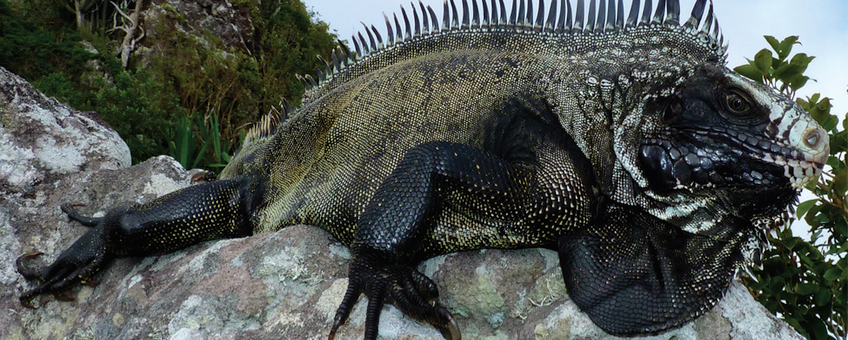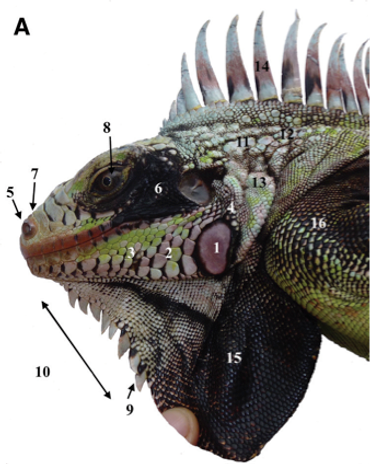
Protecting Saba’s Painted Black Iguanas
Dutch Caribbean Nature Alliance (DCNA)
Iguanas are unique reptiles that can be found throughout the Caribbean and surrounding areas of Central and South America. Previously, three species of iguanas were known to inhabit the Lesser Antilles. These included the Lesser Antillean iguana (Iguana delicatissima, found in only very few islands including St. Eustatius), the common iguana (Iguana iguana iguana, introduced from South America represented also by the two newly described endemic subspecies I. iguana sanctaluciae from Saint Lucia and I. iguana insularis from Saint Vincent and the Grenadines, and Grenada) and the introduced Iguana rhinolopha from Central America. New research points to a fourth species, the painted black iguana (Iguana melanoderma) found on the islands of Saba and Montserrat, along with St. Croix, St. Thomas (US Virgin Islands) and the islands of Margarita, Los Roques and La Banquilla (Venezuela) (Lazell, 1973; van Buurt, 2005). Using physical characteristics and genetic testing, Dr. Michel Breuil and his colleagues are working to fully describe this new species and hope to encourage conservation efforts to protect this unique iguana. This was recently published in ZooKeys journal.
Painted Black Iguana
The painted black iguana, locally known as the Saba Black Iguana, is considered an important flagship species on Saba. However, its uniqueness also makes it a target, as it is a high valued species within the pet trade. Iguanas are often hunted for food as well, are killed by other predators and suffer from habitat loss by overgrazing of livestock and natural events such as hurricanes and volcanic eruptions. Furthermore, this species faces threats through competition and hybridization with other invasive iguana species. It is expected that even more invasive iguanas could reach these islands as trade and shipping increases throughout the Caribbean, particularly through post-hurricane restoration activities.

In Saba, this iguana can often be found living within a wide variety of habitats, including cliffs, trees, bushes and shrubland. Interestingly, these iguanas can also be found within the foggy, cool environment of the higher elevated forests. It is suggested that the darker coloration of these lizards may aid in a more rapid increase of their body temperatures while sunbathing in these cooler environments (Breuil, 2013, 2016). Although there has not been a complete population count, rough estimates suspect populations of between 100-300 individuals on each island (Breuil et al., 2020).

Conservation
Separating the painted black iguana from other species of iguanas allows researchers, conservationists and maritime and airport authorities the ability to differentiate between endemic and invasive iguana species. As tourism, trade and travel increase between the islands, there is an increase in the likelihood of additional invasive species being introduced (Yokoyama, 2012). Iguanas are listed as CITES Appendix II species, for which trade is controlled and an export permit is required. Islands need to be very careful with introducing or exporting iguanas or iguana derived products to protect their endemic iguana.
Besides biosecurity, increasing public awareness of this endemic species is also a critical first step. Understanding the importance and uniqueness of this species will help drive interest in their conservation. In addition, minimizing road kill incidents, hunting and habitat conservation are essential for safeguarding the painted black iguana. Although more research is needed to fully describe the painted black iguana, this study sheds light on the importance of protecting this flagship species for the islands of Saba and Monserrat.
Fortunately, there is something you can do to help! Please report any sightings or photos you have of the painted black iguana on dutchcaribbean.observation.org. This is a free website and app which allows local citizens to report sightings of important plants and animals. These tools are available in over fourty languages and can be used by biologist and citizens alike. Species reports by local communities are invaluable for nature conservation efforts to help increase public awareness and overall species protection.
For more information see this article (Breuil et al., 2020).
Text: Dutch Caribbean Nature Alliance
Pictures: Michel Breuil (lead photo: old Iguana melanoderma from Saba)
